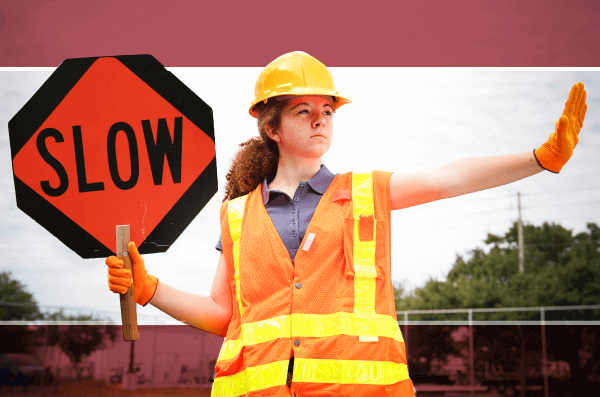
It might seem like the Tri-State has two seasons – winter and construction season. Orange barrels tend to sprout up every spring and remain visible all the way through the fall months. Tri-State drivers are accustomed to narrowed lanes, traffic cones, orange barrels, and alternate routes – so much so that we’re likely to not give construction zones a second thought as we travel through them. But for the over 140,000 road construction workers in America, construction zones can be dangerous – and often deadly.
Workers in road construction zones are three times more likely to be killed on the job than their counterparts in other construction areas, and eight times more likely to lose their lives than general industry workers. And it’s not just road workers who are endangered – motorists account for 85% of fatalities in construction zones.
Traffic Control in a Construction Zone
Perhaps not surprisingly, the Federal Highway Administration (FHWA) has establishedguidelines for traffic control in and around construction zones. Factors such as speed limits, warning areas, lane merging, and signage are all considered in these guidelines, which aim to standardize zones for maximum safety.
Rules of the Road in Construction Zones
Whether it’s a temporary or short-term construction zone such as those set up around utility work or pothole patching, or a long-term zone where an established road is being reconstructed, the rules of the road are altered and the consequences are often greater for violators.
- Slow down upon entering a construction zone
- Follow posted speed limits while traveling within the zone
- Resume normal speed only after signs outside the work zone advise you to do so
- Allow for braking space between your vehicle and the one in front of you
- Do not pass on the shoulder or cross the median
- Stay focused – resist the temptation to use your cell phone, eat, or play with the radio,
- Stay calm – it only takes an extra 25 seconds to cover a mile at 45mph compared to 65mph
Facing the Consequences
While the FHWA has established guidelines that in are in use across the nation, each state has its own set of laws outlining the consequences of motorists failing to follow work zone rules.
In Indiana, fines for speeding in a work zone are significantly higher, and workers don’t need to be present for a violator to incur these fines. A first-time speeder in a work zone can expect a fine of $300, whereas a second offense will cost $500. A third offense within a three-year span nets a fine of $1000. Motorists who drive recklessly or aggressively can rack up a $5000 fine, and a motorist that injures or kills a highway worker in a work zone can expect a fine up to $10,000 and up to six years behind bars.
The bottom line? That 25 seconds you would save by speeding through a work zone isn’t worth it.
While no one particularly enjoys being routed through a construction zone, the fact is, the rules exist to protect both motorists and workers within the zone. Construction zones are often close quarters, with workers performing their jobs within mere feet of oncoming traffic. A worker injured by a motorist in a work zone could be unable to work for weeks, months, or even years. Some may never be able to work again.
If you, a family member or a friend has been injured on the job in a construction zone, seek the advice of an attorney experienced in road construction law. Your attorney will thoroughly investigate the circumstances of your accident in order to determine the proper course of action, seeking appropriate compensation for your injuries and their aftermath. Gerling Law has extensive experience working with victims of road construction accidents, and can help you to get the justice you deserve.
